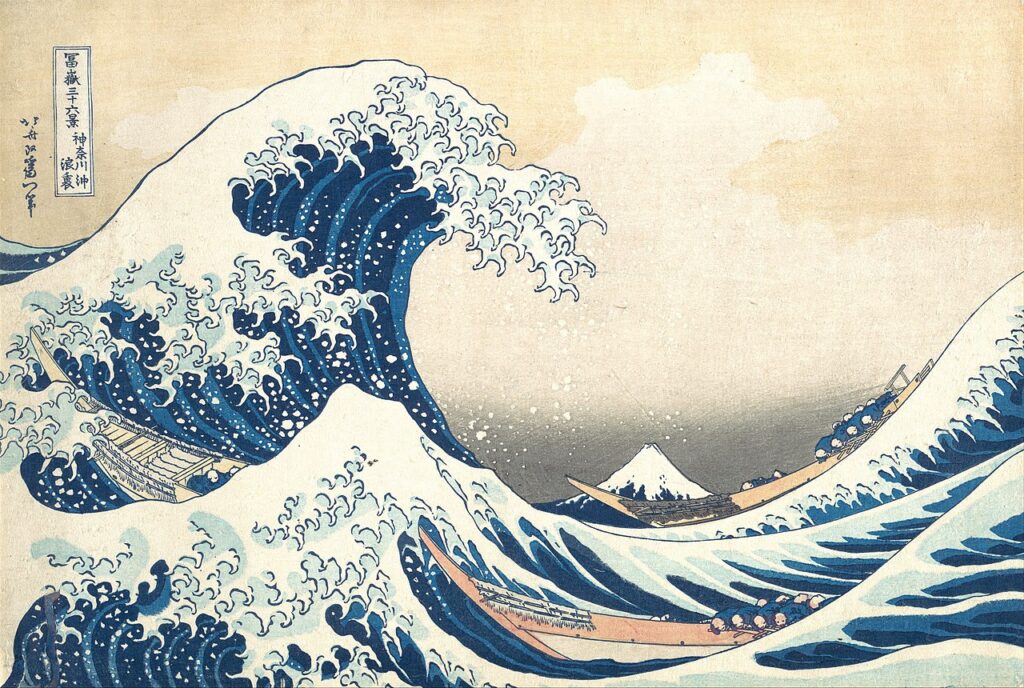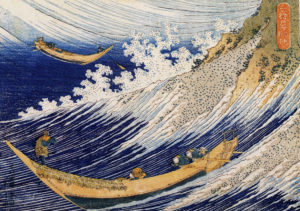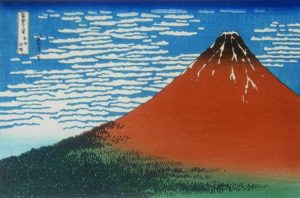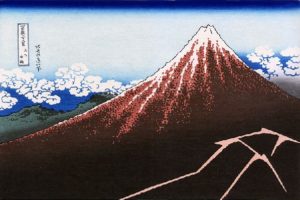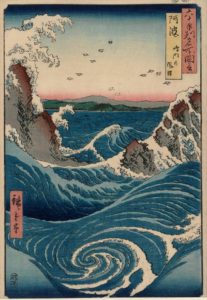The Japanese big wave art, The Great Wave off Kanagawa(kanagawa oki nami ura)
‘The Great Wave off Kanagawa’ (woodblock printing) is one of the most famous art not only of Katsushika Hokusai (1760-1849)‘s prints but also throughout the country(but actually, there are quite a few Japanese who do not know the title of the picture…).
You might not be able to imagine from the powerful woodblock print, but when Hokusai drew the series of “Thirty-Six Views of Mount Fuji” including the wave painting, he was already over 70 years old.
The print influenced the western culture. Vincent Van Gogh acclaimed the artwork and Claude Debussy got the idea of the symphonic poem “La Mer (The Sea). I would like to introduce the other facts about ‘The Great wave off Kanagawa’.
Related Post
Process
Hokusai adopted Prussian Blue throughout this series, that gave the sky and the sea a sense of transparency. At that time, the pigment was really expensive in Japan. But he used the color effectively in the great wave art particularly.
When designating the color of this picture, he instructed a suri-shi(摺師, coloring artist) to choose Prussian Blue instead of Black ink as the outline(the designation of the color of the ukiyo-e was decided by a painter).
Compared to other pictures in this series, you would well understad, this sky is a pretty
ambiguous color. He make the dull sky to express the stormy weather and to emphasize the vivid color of the waves.
Related Post
His idea and technique made the entire screen softer and brighter.People call his distinctive blue as “Hokusai Blue”.
What’s the meaning of the image? The analysis.
In contrast to the quietness of Mt. Fuji, which is far and small, the high waves are raging and striking the ship.
The contrast between distant view and near view is also a characteristic picture. And Katsushika Hokusai expressed the human’s powerless and the grandness of the nature.
In front of the raging waves like sharp nails, all people can do is shrinking their bodies and without moving. It is a composition that impressively expresses stillness and movement invented by Hokusai.
Thorugh the work of “Thirty-Six Views of Mount Fuji”, he did not just draw the pictures with emphasis on a scenery he saw, and this picture may have been combined two or more viewpoints.
It is difficult to identify the spots, but still, the ukiyo-e print is thought that based on what was seen from the offshore of Kisarazu-shi, Chiba Prefecture considering from the shape Mt. Fuji and title of ‘wave off Kanagawa’.
The three ships like an unreliable willow leaf were called Oshiokuri-sen(押送船), and the sailor rowed the oar without sails. They carried the fishes caught in the sea near the Boso Peninsula(Chiba Prefecture) on this boat and brought it to Edo in Kanto area.
The artworks of The Great Wave off Kanagawa also led to the Hokusai’s later series of “Oceans of Wisdom “(One Thousand Images of the Sea).
Related Artworks
If you want to enjoy Japanese artworks of painting, print, and craft everyday, check the Twitter account of Masterpiece of Japan!
You can also see the tweets on the sidebar!
Related posts:
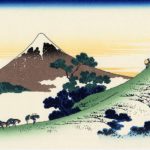 Katsushika Hokusai’s 36 views of Mt.Fuji all prints
Katsushika Hokusai’s 36 views of Mt.Fuji all prints
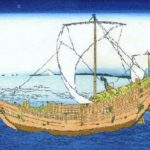 Mt. Fuji art print, ‘The Kazusa Province Sea Route’ by Katsushika Hokusai
Mt. Fuji art print, ‘The Kazusa Province Sea Route’ by Katsushika Hokusai
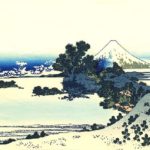 ‘Shichiri beach in Sagami Province’ art by Katsushika Hokusai
‘Shichiri beach in Sagami Province’ art by Katsushika Hokusai
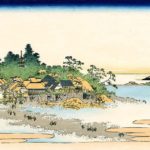 Mount Fuji art painting, ‘Enoshima in Sagami Province’ by Katsushika Hokusai
Mount Fuji art painting, ‘Enoshima in Sagami Province’ by Katsushika Hokusai
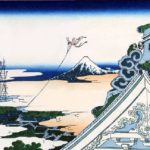 ‘Asakusa Hongan-ji Temple in the Eastern Capital’ by Katsushika Hokusai
‘Asakusa Hongan-ji Temple in the Eastern Capital’ by Katsushika Hokusai
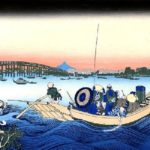 ‘Sunset across the Ryōgoku Bridge…’ ukiyo-e art by Katsushika Hokusai
‘Sunset across the Ryōgoku Bridge…’ ukiyo-e art by Katsushika Hokusai

